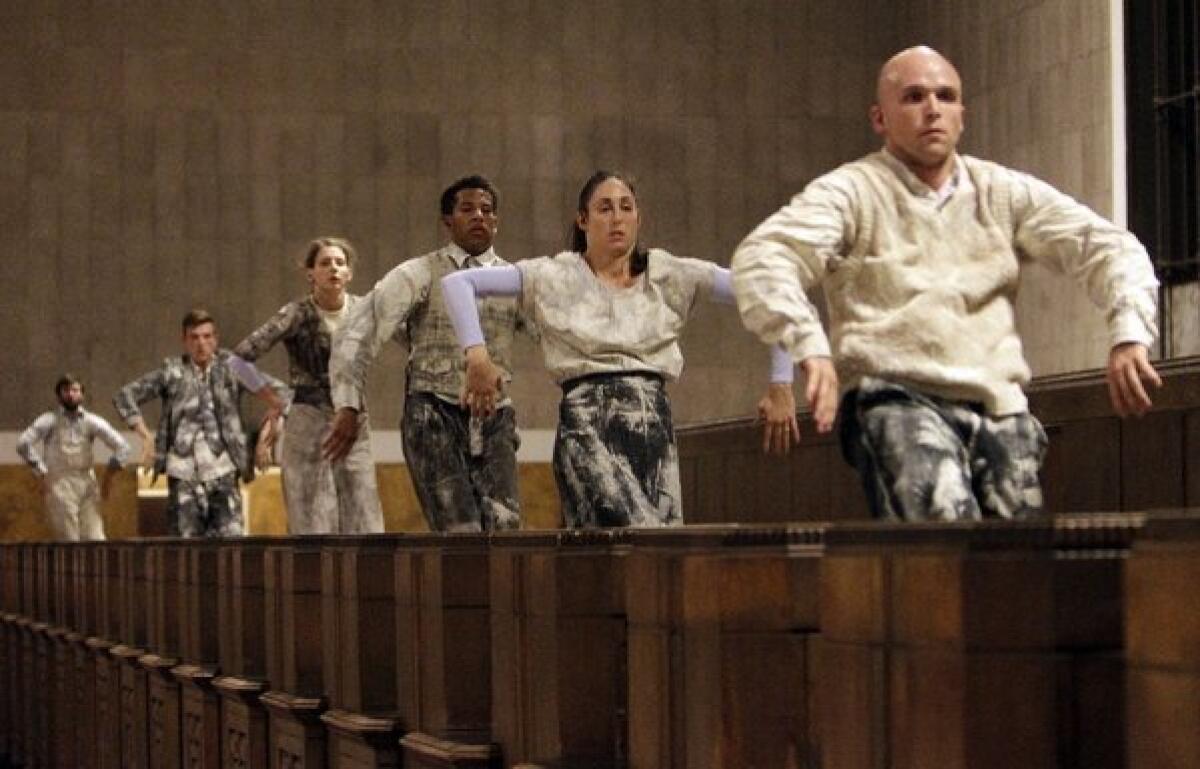Review: An inward tour through ‘Invisible Cities’

- Share via
If you hoped to catch the twilight Pacific Surfliner on Saturday at Union Station, you first had to pass through the Twilight Zone. The sign on the information booth read: “Please do not bother the nice person on the computer. She is part of an opera performance.”
Dancers in imaginative traveling outfits might have obstructed your path or simply distracted you with some ferocious funny business on the floor. You would have had further need to jostle past a couple hundred gawkers sporting large headphones and not going where you were going or hearing what you were hearing.
Their destination was not San Diego nor any place tangible but “Invisible Cities.” This was the premiere of a new opera by Christopher Cerrone, a startlingly ambitious project by the venturesome opera company the Industry.
PHOTOS: Best in theater for 2012
The idea of putting on an opera in a train station where the characters can be nearly indistinguishable from everyday people in the waiting rooms is a strange and alluring subversion of Samuel Johnson’s oft-quoted characterization of opera as “an exotic and irrational entertainment.” But that’s just the beginning of an existential confusion between reality and unreality, of the private experience of listening to the opera on headphones while participating in the activities of a public space.
Cerrone’s opera is based on Italo Calvino’s 1972 poetic Italian novel, “Invisible Cities,” in which the explorer Marco Polo entertains and bewilders the aging 13th century Mongolian emperor Kublai Khan with tales of travels to 55 mysterious cities. All are — like latter-day Lake Wobegons — imaginary places defined by the sum of their seemingly quotidian peculiarities.
The emperor asks his Venetian guest why he leaves out the fabled Venice. Polo answers that cities must be conjured from memory and desire. By inventing cities of the living and the dead, of the past and present, of the real and the unreal, he ultimately shows Khan his Venice. The emperor must invent his own invisible cities.
And so must we in experiencing Cerrone’s opera.
PHOTOS: LA Opera through the years
The performance began communally with a short overture performed by an 11-member ensemble, which stays put throughout the 70-minute performance in a room apart from the main station. Most on Saturday were not tempted to remove headphones here, although the room’s acoustics were first-rate. The confusion between virtual and visceral had already begun.
Cerrone is a composer based in Brooklyn who turns 30 next year, and his instrumental writing has the quality of glittery, half-lighted surfaces enhanced by Postminimalist patterns. His vocal style is lyrical and owes a debt to John Adams. There are fanciful dramatic outbursts as well, but mostly the score sounds as if it floats, very agreeably, on an acoustical cushion slightly lighter than air.
After the overture, we were on our own for the next hour, free to wander the waiting rooms and other public areas, indoors and out, while listening to the live performance on the headphones. However, Yuval Sharon — the artistic director of the Industry, the stage director of the performance and the mastermind of the project — provided several helpful suggestions in the program booklet.
ART: Can you guess the high price?
These included buying a drink at the bar or taking off the headphones and enjoying the silence. But most of us, operagoers that we are, scouted out the performers and pursued them. That was relatively easy because all you had to do was pay attention to the crowds.
Cerrone’s libretto stays close to William Weaver’s excellent translation of Calvino’s Italian text. Three cities, though, must stand for the rest. Isidora is a place of spirals and young love enviously observed by the old. Armilla has no walls, no ceilings, no floors, just pipes and rushing water and slender young women luxuriating “under the showers suspended in the void.” Adelma is where the dead come to life.
Sharon’s production is meant to stimulate discovery. Sooner or later you look up and find the text projected on a wall. You discover that the angry-looking fellow in a wheelchair — no, not that one but the other one — is Kublai Khan (Cedric Berry). I missed Marco Polo (Ashley Faatoalia) most of the time. He was heavy-set, in a plaid shirt, hooded vest and carrying a backpack.
CHEAT SHEET: Fall arts preview
There are many, quite literally, moving parts to this production, which is a collaboration with Los Angeles Dance Project. Choreographer Danielle Agami installs the eight dancers into a wide variety of scenic elements. They rush through the station like hurried balletic commuters. They brawl. They become statuary in outdoor spaces. They seductively take over the ticket booths. They are ravishingly outfitted by costume designer E.B. Brooks.
The singers include two stately women (Delaram Kamareh and Ashley Knight) who take on a variety of roles and a three-member chorus. All appear and disappear, mirage-like. No one sees everything.
There are issues and questions raised. The opera audience, with our headphones, is ostentatious. We who gawk are gawked at. The homeless also take shelter here, which adds an uncomfortable element of slumming. Self-congratulating politicians who spoke afterward didn’t help matters. The worst was an intrusive documentary camera crew, bulls with bright lights in an operatic china shop.
It would not have, thus, been hard for Sharon’s herculean act of coordination and inventive production to overwhelm a delicate and beautiful opera. Importantly, it didn’t. Somehow, even the performance, conducted by Marc Lowenstein, remained sensitive in so intimidating a performance space.
“Invisible Cities” is enhanced by, but, like Polo’s Venice, not defined by exteriors. It could be, and should be, done anywhere.
More to Read
The biggest entertainment stories
Get our big stories about Hollywood, film, television, music, arts, culture and more right in your inbox as soon as they publish.
You may occasionally receive promotional content from the Los Angeles Times.











